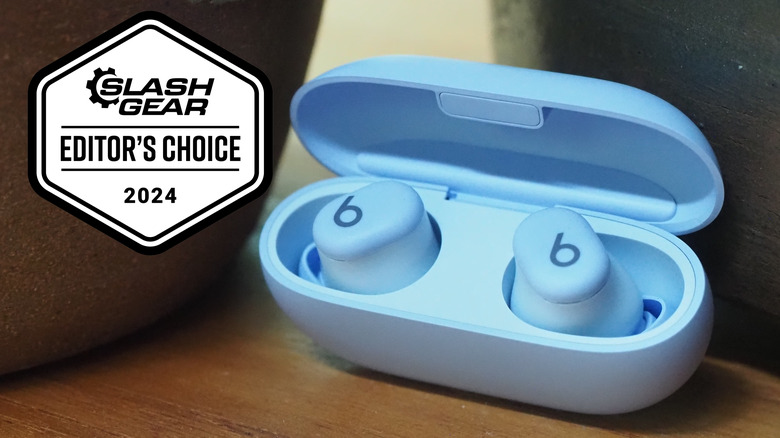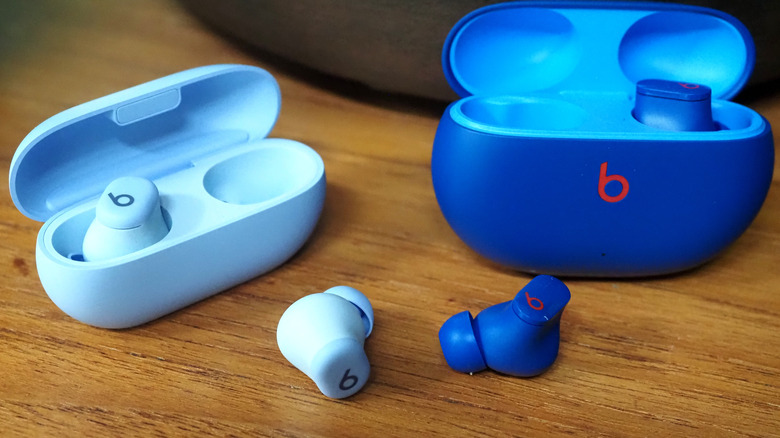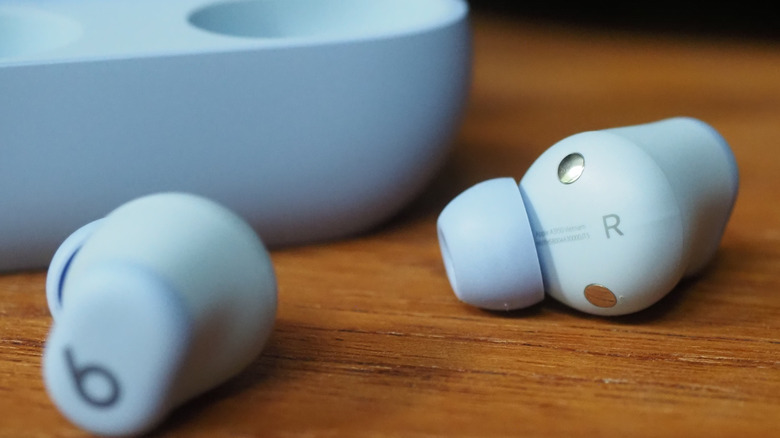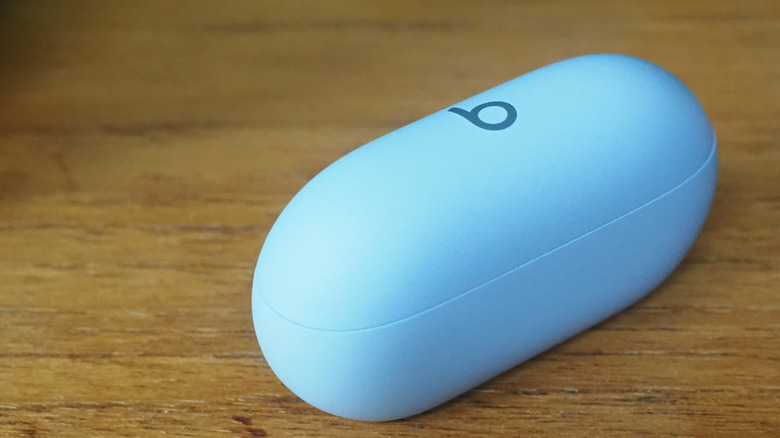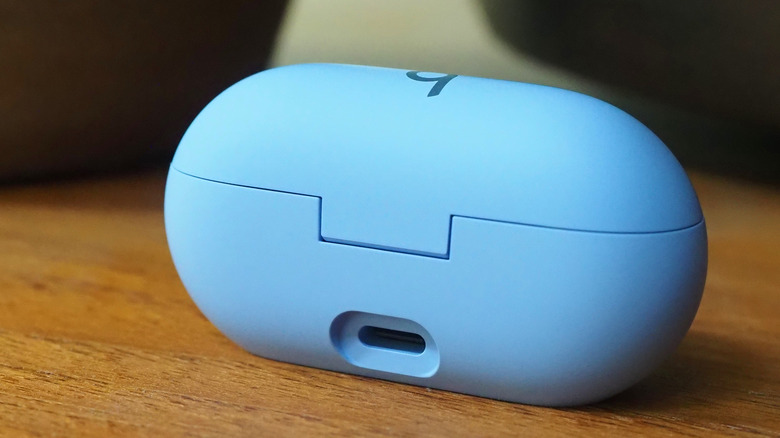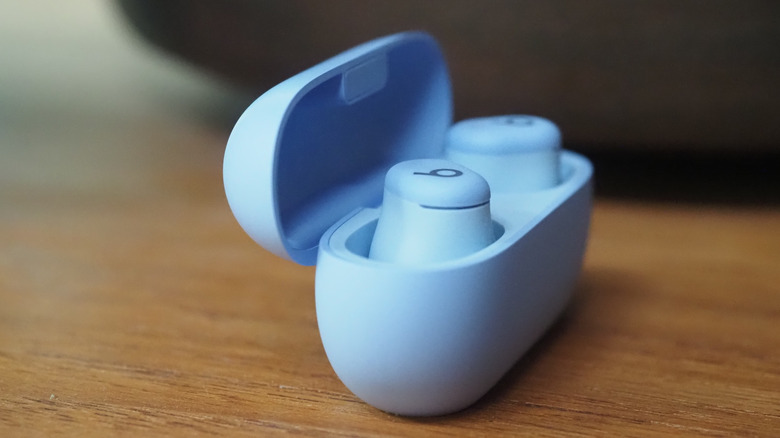Beats Solo Buds Review: Tiny Case And Big Sound, But At The Cost Of Some Features
- Long battery life from the earbuds alone
- Solid sound quality
- Tiny case is easily carried
- iPhone and Android users are treated equally
- No ANC or wireless charging
- No EQ adjustment
- Microphone performance only average
We may receive a commission on purchases made from links.
You could make a solid argument that the clever part of Beats Solo Buds isn't what you push in your ears, but what lives in your pocket. The audio accessories-maker's latest wireless earbuds are its cheapest, at $79.99, and deliver a hefty 18 hours of uninterrupted playback, but it's the case–offered in Arctic Purple, Storm Gray, Matte Black, or the eye-catching Transparent Red–that's notable for what's not included. That is to say, bulk, or a battery.
While the idea of true wireless earbuds without a battery case may seem odd now, it's arguably a fix to one of the most obvious issues of early models: the batteries in the earbuds themselves simply weren't powerful enough. Though these days we're used to dropping earbuds into a charging case to give them a periodic top-up, in an ideal world the buds themselves would have sufficient power to make that unnecessary.
That's what Beats has done with Solo Buds, reaping the benefits in overall case size in the process. Of course, it also ran into some compromises along the way, not least the absence of nice-to-have features like active noise cancellation. So, the question is, does Beats Solo Buds' minimal hit in your pocket, and on your wallet, justify those omissions?
A teeny, tiny case
Side by side with an earlier set of Beats wireless earbuds, you can instantly see the big change the Solo Buds usher in: the case is tiny. Beats says it's about 40% smaller than the Solo Buds+ case, and its 2.6 inch long, 1.4 inch tall lozenge slips easily into a pocket or purse. The magnetically-latched lid is firm enough not to worry about inadvertently popping open in either situation.
It's not only a battery which the case lacks. There's no pairing button–you hold down either of the earbud's buttons, while they're still in the case, to enter pairing mode–and no LED to indicate charging or power status. Instead, the earbuds themselves play a soft tone when a USB-C charger is plugged in, or if their power level is low.
Beats includes a USB-C to USB-C cable in the box, though no charger. There's also no wireless charging support, sadly, however the USB-C port of an iPhone 15 or recent Android device should be sufficient to top up the Solo Buds (at which point you might wish for a slightly shorter cable). Five minutes of charging from dead is enough for up to an hour of playback; a full charge takes about 80 minutes.
Light and comfortable despite the big battery
That full charge, Beats says, should last up to 18 hours. Now, a set of Beats Studio Buds+ claims 36 hours, but that's including a top-up in the case: the earbuds alone last just nine hours apiece.
Admittedly, doing away with the case battery in favor of more earbud power doesn't make such a big difference as it might've in the days when most wireless earbuds lasted four hours at most. The likelihood of someone spending an entire New York to Singapore flight with their Solo Buds in and playing seems minimal. Yet the downside you might expect–heavier, and thus less comfortable buds–doesn't arise. It's tough to tell the difference between this and Beats' earlier designs.
While the shape is slightly different to that of Studio Buds+, the Solo Buds are pretty much in line with those earbuds. Beats includes four different rubber ear-tip sizes, though the ergonomically-advantageous fins that help the Beats Fit Pro sit so snuggly in the ear are absent. That's a shame, as it leaves the Fit Pro my go-to earbuds (admittedly I have fairly odd-shaped ears, and buds that rely on a friction fit with the ear tip to stay in place get uncomfortable for me rapidly).
iPhone and Android users are both welcome, here
Each Solo Bud has a multi-function button — physical, not touch-sensitive: you always know you've pressed it, but doing so can move the bud in your ear and potentially spoil the seal — to control playback and calls. One tap for play/pause or answer a call; double-tap to skip forward or end a call; triple-tap to skip back. Holding the button down triggers your phone's voice assistant — there's no "Hey Siri" voice activation, here — or can be switched to adjust volume.
That change is made either in the iOS Settings or the Beats app for Android. As with other Beats products–like the Solo 4 headphones–and belying the company's Apple owners, the Solo Buds treat iPhone and Android users just about equally. Both platforms get one-touch and ecosystem pairing, along with Find My support. iOS has Audio Sharing support, while Android has the even more useful multi-point Bluetooth, for quicker switching between multiple paired devices.
Sadly, as well as active noise cancellation (ANC) being omitted, despite what the settings might suggest there's no in-ear detection to automatically pause playback if you pop out an earbud. They will, though, do that if you put a Solo Bud back into the case.
Sound similar to Beats' more expensive earbuds
Given Beats has reused the transducer from the Studio Buds+, it's no great surprise that the sound profile here is similar. The interior design of the acoustic chamber is new, but there's still the same balanced (but not too thumpy) bass and perky high-end. In fact, those expecting Beats' notorious–and, in recent years, not really true–surfeit of low-end may be surprised to find how tempered the Solo Buds are.
For most musical styles, that decision works just fine. Beats' tuning flatters vocals, and pulls plenty of detail out of the mid-range, too. Without ANC ousting environmental noise, I did find I had to turn the volume up higher than with, say, Beats Fit Pro or Apple's AirPods Pro. It's a reminder that, in addition to creating a bubble of hush around you, active noise cancellation can also help reduce discomfort from extended listening at higher volumes.
Unfortunately there's no way to tweak the EQ of the Solo Buds, if you do want more bass: it's Beats' tuning, or a different set of earbuds. The Fit Pro definitely pulled more detail out of tracks, but given the $120 price delta, so they should. For sub-$100 earbuds, the Solo Buds have surprising clarity and refinement, though I still think Apple AirPods (3rd generation) have the edge when it comes to microphone performance in voice calls.
Beats Solo Buds Verdict
At $79.99, it's hard to dislike the Beats Solo Buds. Certainly, ANC would be nice, as would wireless charging. The former would've eaten into the impressive battery life, however, and the latter made the case bigger, and added to the overall price. Unlike Studio Buds+ and Fit Pro, there's no IPX4 water resistance rating, though Beats insists that some workout sweat shouldn't be a problem. Pick something else if you're going on a rain run.
Compared to the Studio Buds they replace, the Solo Buds are $20 cheaper, lack ANC, but sound better. Studio Buds+ cost $90 more but promise longer (overall) battery life, water resistance, and active noise cancellation. In the middle are Apple's AirPods (2nd generation), at $129 (though with a street price currently matching Solo Buds), with a slightly more full-featured set of talents if you're an iPhone user (and far fewer than Beats if you're on Android).
My money would be on Solo Buds at that point — and, if I was weighing Studio Buds+, a roughly $160 street price for Beats Fit Pro would sway me that way instead — for their flexibility, musicality, and lengthy battery life. An individual AirPod lasts just four hours on a charge, by way of contrast. Beats Solo Buds may not be the most full-featured option on the market, but by cutting out a case battery they've delivered far closer to the original vision of true wireless earbuds than most.
